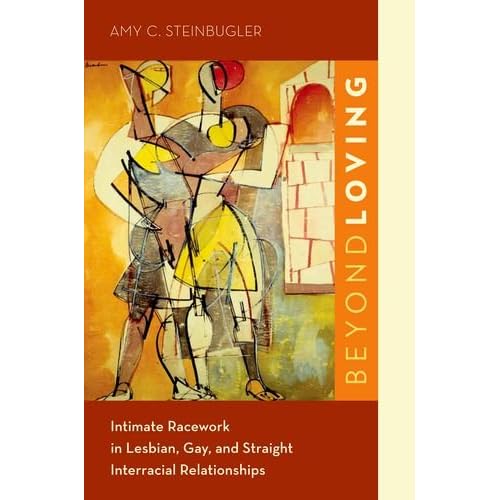Beyond Loving: Intimate Racework in Lesbian, Gay, and Straight Interracial RelationshipsPosted in Books, Gay & Lesbian, Media Archive, Monographs, Social Science on 2013-02-08 01:39Z by Steven |
Beyond Loving: Intimate Racework in Lesbian, Gay, and Straight Interracial Relationships
Oxford University Press
2012-08-07
240 pages
6-1/8 x 9-1/4
ISBN13: 9780199743568; ISBN10: 0199743568
Amy C. Steinbugler, Assistant Professor of Sociology
Dickinson College, Carlisle, Pennsylvania
Beyond Loving provides a critical examination of interracial intimacy in the beginning decades of the twenty-first century—an era rife with racial contradictions, where interracial relationships are increasingly seen as symbols of racial progress even as old stereotypes about illicit eroticism persist. Drawing on extensive qualitative research, Amy Steinbugler examines the racial dynamics of everyday life for lesbian, gay, and heterosexual Black/White couples. She disputes the notion that interracial partners are enlightened subjects who have somehow managed to “get beyond” race. Instead, for many partners, interracial intimacy represents not the end, but the beginning of a sustained process of negotiating racial differences. Her research reveals the ordinary challenges that partners frequently face and the myriad ways that race shapes their interactions with each other as well as with neighbors, family members, co-workers and strangers. Steinbugler analyzes the everyday actions and strategies through which individuals maintain close relationships in a society with deeply-rooted racial inequalities-what she calls “racework.” Beyond Loving reveals interracial intimacy as an ongoing process rather than a singular accomplishment. This analytic shift helps us reach a new understanding of how race “works” – not just in intimate spheres, but across all facets of contemporary social life.
Features
- Interviews with same-sex interracial couples–a topic on which there is very little research—allow Steinbugler to examine for the first time how everyday racial practices are shaped by sexuality and gender.
- Amy Steinbugler challenges the widespread assumption that interracial intimacy represents the ultimate erasure of racial differences.
Table of Contents
- Acknowledgements
- Introduction
- Chapter 1: The Historical Roots of Lesbian, Gay, and Heterosexual Black/White Intimacy
- Chapter 2: Public Interraciality: Navigating Racially Homogeneous Social Spaces
- Chapter 3: Public Interraciality: Managing Visibility
- Chapter 4: Intimate Interactions: Racework as Emotional Labor
- Chapter 5: Interracial Identities: Racework as Boundary Work
- Chapter 6: White Racial Identities Through the Lens of Interracial Intimacy
- Conclusion: The Intimate Politics of Interraciality
- Appendix A. Research Methods
- Appendix B. Respondent Characteristics
- Table 1. Design of Interview Sample
- Table 2. Sample Details by Group

